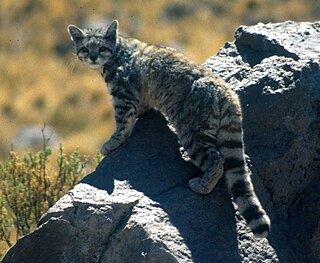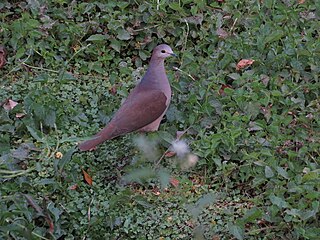
The rufous-throated dipper or Argentine dipper is an aquatic songbird found in South America, and is part of the dipper family.

Jacaranda mimosifolia is a sub-tropical tree native to south-central South America that has been widely planted elsewhere because of its attractive and long-lasting violet-colored flowers. It is also known as the jacaranda, blue jacaranda, black poui, Nupur or fern tree. Older sources call it J. acutifolia, but it is nowadays more usually classified as J. mimosifolia. In scientific usage, the name "jacaranda" refers to the genus Jacaranda, which has many other members, but in horticultural and everyday usage, it nearly always means the blue jacaranda.

The Andean mountain cat is a small wild cat native to the high Andes that has been listed as Endangered on the IUCN Red List because fewer than 1,500 individuals are thought to exist in the wild. It is traditionally considered a sacred animal by indigenous Aymara and Quechua people.

Calilegua National Park is a federally protected area in Jujuy Province, Argentina. It was established on July 19, 1979, and is also the largest protected area in Argentina dedicated to conserving subtropical evergreen mountain rainforests known as Southern Andean Yungas. These Yungas, are transitional zones between the Andean highlands and the eastern forests.

The Yungas is a bioregion of a narrow band of forest along the eastern slope of the Andes Mountains from Peru and Bolivia, and extends into Northwest Argentina at the slope of the Andes pre-cordillera. It is a transitional zone between the Andean highlands and the eastern forests. Like the surrounding areas, the Yungas belong to the Neotropical realm; the climate is rainy, humid, and warm.

Aconquija National Park, formerly known as Campo de los Alisos National Park, is a federal protected area in Tucumán Province, Argentina. Established on 9 August 1995, it houses a representative sample of the Southern Andean Yungas montane forest biodiversity in good state of conservation.

Aspidosperma quebracho-blanco, commonly known as Quebracho blanco, kebrako, or white quebracho, is a South American tree species, native to Brazil, northern Argentina, Bolivia, Paraguay, and Uruguay. It must not be confused with other species also known as quebracho, but belonging to the genus Schinopsis.

The puna grassland ecoregion, part of the Andean montane grasslands and shrublands biome, is found in the central Andes Mountains of South America. It is considered one of the eight Natural Regions in Peru, but extends south, across Chile, Bolivia, and western northwest Argentina. The term puna encompasses diverse ecosystems of the high Central Andes above 3200–3400 m.
Gastrotheca gracilis, commonly known as the La Banderita marsupial frog, is a species of frog in the family Hemiphractidae. It is found in northwestern Argentina and possibly Bolivia.

The grey-hooded parakeet, also known as the Aymara parakeet or Sierra parakeet, is a species of parrot in the family Psittacidae. It is found in northwestern Argentina and Bolivia. Its natural habitat is subtropical or tropical high-altitude shrubland.

The Yungas pygmy owl, is a species of owl in the family Strigidae. It is found in Argentina, Bolivia, and Peru.

The Yungas dove, also known as the white-faced dove or large-tailed dove, is a species of bird in the family Columbidae. It is found in Argentina and Bolivia.

The red-backed sierra finch is a species of bird in the family Thraupidae.

The rufous-sided warbling finch is a species of bird in the family Thraupidae. It is found in the Southern Andean Yungas of Argentina and Bolivia. Its natural habitat is subtropical or tropical high-altitude shrubland.

The southern viscacha is a species of viscacha, a rodent in the family Chinchillidae found in Argentina, Bolivia, Chile, and Peru. It is a colonial animal living in small groups in rocky mountain areas. It has long ears and hind legs and resembles a rabbit in appearance apart from its long, bushy tail, but is not a lagomorph.

The Southern Andean Yungas is a tropical and subtropical moist broadleaf forest ecoregion in the Yungas of southwestern Bolivia and northwestern Argentina.

The Bolivian Yungas is a tropical and subtropical moist broadleaf forest ecoregion in the Yungas of central Bolivia.

The Yungas sparrow is a species of bird in the family Passerellidae endemic to the Southern Andean Yungas of southeastern Bolivia and northwestern Argentina. It was formerly considered a subspecies of what was then called the stripe-capped sparrow.

The Yungas guan is a species of bird in the family Cracidae, the chachalacas, guans, and curassows. It is found in the Andean foothills of Argentina and Bolivia.
Ocotea porphyria is a species of evergreen tree in the laurel family (Lauraceae). It is native to southern Bolivia and northwestern Argentina, where it lives in humid montane forests, or Yungas, on the eastern side of the Andes. Common names include laurel del cerro, laurel la falda, laurel tucumano, and ayuínandí.



















